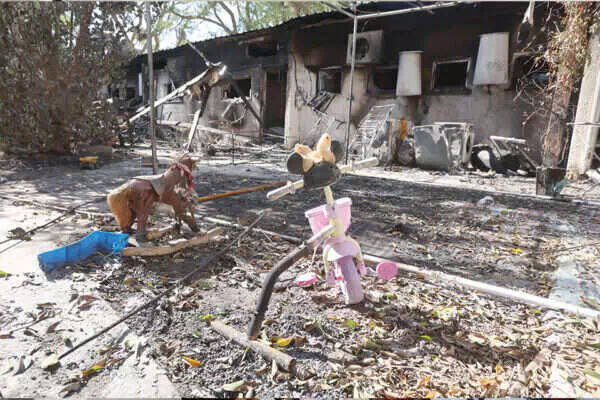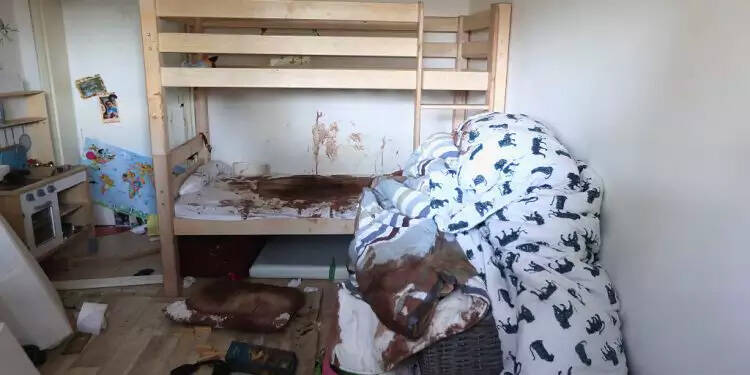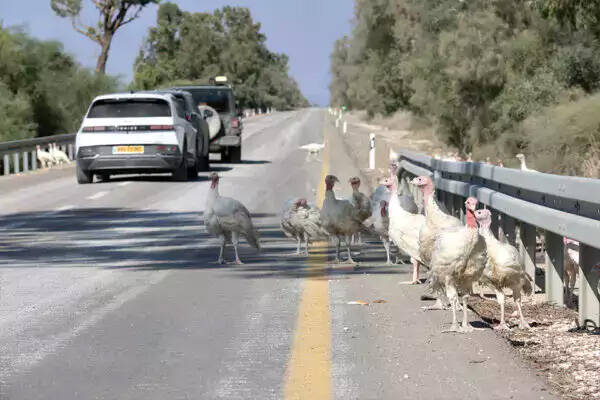‘This is where the killer stood and slaughtered the children’
NIR OZ — On Route 242, at the northern exit from Nir Oz, facing the IDF jeep, a surreal scene unfolds: Thousands of turkeys that fled from the kibbutz’s coops are slowly wandering everywhere — on the road, in the yellow fields, under the eucalyptus trees.
They are looking for food, clucking, gathering in shaded areas. Dozens of them have already been run over on the asphalt. The western Negev, a thriving and prosperous region, is now a disaster zone.
We set out to explore the torched homes of Nir Oz, along the scorched paths of Be’eri, within the sandstorm that still shakes the banners and props that were set up for the nature rave near Re’im, where hundreds of partygoers were slaughtered.
Every leader should know, every commander should remember, and every citizen should be aware. The October 7th War should fortify our borders for the next hundred years.
At the entrance to kibbutz Nir Oz, we encounter a reserve duty major who has been hosting “guided tours.” The world needs to see this.
We move to the first house, in front of which there are eight damaged and broken cars; some of them bearing graffiti in Arabic. Inside the house, the smell and the sights are just unfathomable. Some of us are combat veterans, and we’ve seen friends lying lifeless, but nothing can prepare the soul for the torn-up living room, the shattered kitchen, the shattered porch, and the open thriller book lying on the double bed after a long Friday night reading.
This is a kibbutz home with a scent of the past: 60 square meters of humanity, now decimated. Family photos hang on the wall, and at the entrance, the colorful kindergarten schoolbags of the children hang on colorful hooks.
Happiness, childhood, love that was tainted with blood, with signs of difficult struggles, of survival. Opposite the children’s rooms — a laundry basket with a pile of clean clothes to be sorted, and next to it, a play area with dominoes, Monopoly, and a Lego helicopter. Another children’s room with blood-soaked carpet on the floor.
And thus, from house to house, between the lush meadows and the scorched houses, our footsteps traverse the paths of death. The pastoral atmosphere of the kibbutz, the chirping of grasshoppers, and the lush greenery are disrupted only by the sounds of the soldiers patrolling every corner.
At the front of one of the houses stands a sukkah, open to the wind. One of the sheets had been torn, and right around the corner, a window to a child’s room. A black book just below the window. If you step on the chair, you can see the horror inside: a bunk bed whose sheets are infused with blood; this is where the killer stood and slaughtered the children.
“Sukkot, the Harvest Festival” is written in cardboard letters at the entrance. In the surrounding kibbutzim, time froze on the joy of Simchat Torah in the morning. When will “After the Holidays” arrive? On one of the dressers, we see baby pacifiers with the children’s names. Opposite them are pictures of the children of the community’s schools, some of whom were killed, and some were kidnapped.
And from the infinite sorrow of Nir Oz — to the site of the party in Re’im. This has become the Hasbara Central in recent days, where Israel makes its case to the world to showcase the Hamas atrocities. There is not a single person in the Arab world who can justify the slaughter of one of the symbols of the free, liberal world: a sunrise party of young people.
When we arrive, we see Knesset Speaker Amir Ohana with the President of the European Parliament, Roberta Metsola, who promises to tell the world. The overturned, charred, bullet-ridden vehicles are still scattered over a huge area. The site destruction is huge. Next to them is a row of portable toilets, here too, the terrorists made sure that everyone would be killed by shooting extra bullets.
At the exit from the party area, the road becomes a road of death. A small above-ground bunker is filled with burnt Nike shoes, backpacks, undershirts, and scattered jeans. Nine young people found shelter in it for a few moments until the murderers reached them.
And then we arrive in Be’eri. Journalists and photographers and ZAKA (community response teams) volunteers whose job is to collect bodies move in the buggies of the kibbutz atop the ruins of the homes that had been when tanks attacked them to overrun the terrorists barricading inside.
What’s left of the once flourishing kibbutz, which stood tall for decades in the Gaza periphery, now resembles scenes from Chechnya and Kosovo. There is not a single intact house; the tracks of the tanks dominate every path in the kibbutz. Alongside them, piles of what were once vehicles, one on top of the other. Water pipes that had burst created massive water puddles in the fields. Bodies of terrorists are still strewn on the outskirts of the houses, and flies swarm between them.
The people are incredible, dealing with the rescue work and the treatment of the victims calmly and with determined faces. Suddenly, one of them, a ZAKA volunteer, arrives in front of us while riding in the kibbutz’s buggy. A mask dangles from his neck, and his sterile gloves are already soiled and slightly torn.
He tells us that bodies have just been discovered — two children were lying in the living room, and in the parents’ room, they found the father and mother. The positions suggest that they had tried to hide, probably after a brutal struggle. No story can lessen the senses, but he is determined to continue until he brings the last of the victims to a Jewish burial.
Outside the fence, 15 bodies were found. They are probably people who had been murdered as they tried to flee. But that is already beyond his responsibility. There is enough work inside the kibbutz.
A moment later, an alert sound on the loudspeaker, blasting “code red” on an incoming projectile. We lie down under a tree; the paratroopers and reservists continue. Between the paths of the kibbutz, special forces soldiers observe and set up ambushes for any scenario. When we exit the area, many forces gather. Regular and reserve soldiers. The morale is high; they prepare the equipment and distribute snacks, but they do not lose alertness. Fighters of all types and units. The people’s army bridged all the gaps. It is here, in the field.
At the gas station on the way to the Sa’ad junction, we stopped for a break. One of the senior officers we met in Gaza makes coffee on a portable stove. He is between assignments, in a brief moment of civilian life, and on Saturday morning when he heard what happened, he rushed to the scene.
Since he’s been inside. He saved lives, killed terrorists, and cared for soldiers. He shares with us a bit of what he’s been through and mostly regrets not taking enough photographs. Despite the combat, he needed to capture the Holocaust-like scenes he witnessed.
“The whole world should have seen and understood. I visited all the places that can be brought to awareness, and I experienced it — but something like this cannot be brought to awareness, it’s something that will haunt me for the rest of my life,” he says.
The sun is already setting, moments before the Sabbath. We gave up on coffee because the wind didn’t allow the fire to dominate. But the officer remains composed. He takes us aside, smiles modestly through his small eyes, and promises, “We will prevail over them.”
Omer Lachmanovitch is the editor of Israel Hayom, Israel’s most widely distributed daily newspaper. Uri Dagon is Israel Hayom’s news director.
Israel Hayom is owned by the Adelson family, including Dr. Miriam Adelson, which also owns the Review-Journal.
























